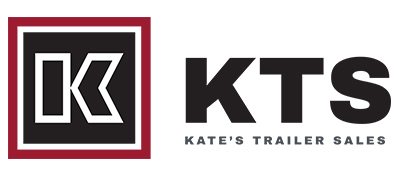Beginner Trailer Towing Made Easy
It’s your first time towing a trailer, and you’re nervous. How do you make those tight turns? How do you combat trailer sway? What about parking? If it’s your first time towing a trailer, these concerns are common. With practice and patience, hauling a trailer will soon become second nature.
At Kate’s Trailer Sales, we know that being familiar with your trailer is the first step in safe, successful towing. Being prepared for anything is critical; you’ll want to understand the basics. Here is our list of safety tips for towing like a pro!
Towing lingo
Just like any other niche, towing has its own language and acronyms. You’ll need to be fluent in order to make the right decisions once you begin towing. Here are a few examples:
- Gross vehicle weight rating (GVWR): The amount of weight a fully loaded down truck can safely carry, as determined by the manufacturer.
- Gross trailer weight rating (GTWR): This tells the consumer the maximum combined weight of the cargo and trailer. This should be attached somewhere on the trailer frame.
- Gross axle weight rating (GAWR): This tells you the weight a single axle can carry without the rest of the rig.
Need more trailer terms and definitions? Read through our full trailer lingo for beginners post.
Weight compatibility
One of the most important factors in learning how to safely tow a trailer is weight compatibility. Cars and trucks both have towing weight limits, and knowing how much your rig weighs can help you tow safely. If you have a certain trailer in mind, make sure your towing vehicle can tow that amount of weight. To find this number, check your owner’s manual. If you are without one, a trip to a local dealer might help. Or you can always check for a downloadable file online.

Always use safety chains
And always pack a spare set! These aren’t required, but you don’t want to be caught without them. They add an extra layer of safety to towing a trailer. Just in case your trailer becomes unattached from your vehicle, the chains are a failsafe to keep everything together until you can stop. This more than likely won’t happen, but it’s such a simple precaution you can take to keep everyone on the road safer. When securing the chains, be sure you leave enough slack for turns, and make sure it is never long enough to drag on the road.
Pay attention to trailer load balance
Most trailer manufacturers suggest distributing about 60 percent of the tow weight onto the front half of the trailer. Once you’ve got the balance right, secure everything with straps. If the weight shifts because the cargo moves, it throws off the load and it could become unbalanced. A balanced trailer and secured cargo will also help prevent trailer sway, a common issue among the most experienced of towers. You can find straps, D-rings and other tools to keep your cargo in place at our trailer parts and service department.
Don’t forget about the hitch ball
The hitch ball is part of the tow vehicle. Most vehicles come with one from the factory and are usually attached to the frame. You can always purchase a high-quality aftermarket hitch, but be sure you’re clear about the weight capabilities. The ball itself does support some trailer weight and functions as a tool to combine the trailer with the tow vehicle.
Always be prepared
You can do everything right, check off each item on a list, do everything the manual tells you, and something could still go wrong in towing a trailer. Make a list of all the tools you might think you need and pack them. This is especially true if you plan to tow in remote areas. Knowing how to fix the little things until you can call for assistance can be a lifesaver!
Practice with a friend
One of the most challenging parts of towing is learning how to park or back up, especially into an actual parking spot. Backing up requires the mirrors to be placed correctly, a bit of patience and a good friend to guide you. Nearly everything comes with backup cameras these days, so it shouldn’t be as difficult as it once was. But it still takes practice and patience. So, throw some cones up in your backyard and practice parking and backing up.

Driving with the trailer
Once you have everything in place, it’s time to hit the road. Driving with a fully loaded trailer in tow isn’t too much different than driving with an empty one, but the techniques are different and can be confused easily.
First, everything you do should be slowed down when driving with a full trailer. This means turns and stopping will take longer, so give yourself more space between you and the person in front of you. Allow yourself much more time and space when merging or changing lanes and be sure to watch for objects in the road so you can give yourself enough time to slow down or avoid the object. You can also try to look farther ahead so you’ll have time to change course or brake if an obstacle is coming your way. Finally, remember that there are additional vehicle safety factors to take into account before towing a trailer.
There you have it! Some of our favorite tips and tricks for your first time towing a trailer. We know it can seem overwhelming and daunting, but anything becomes easier with a bit of practice. As always, contact us here at Kate’s Trailer Sales for all your trailer questions and concerns! We have hundreds of trailers for sale in any model you need, from lightweight utility trailers to heavy-duty equipment trailers. Stop by our central Illinois dealership to find the perfect trailer for you.

